
NEW WAVES OF CHANGE
THE NEW FLORIDA:
1876-1919
THE NEW BOURBON MAJORITY
The return to political power of the Bourbon Democrats did not mean the
overnight destruction of reforms of Reconstruction. Governor George F. Drew was an old-timer Whig, a native of New Hampshire, and a
lumber man with Northern contacts. Drew supported closer contact with Northern
investors and a new diverse economy.
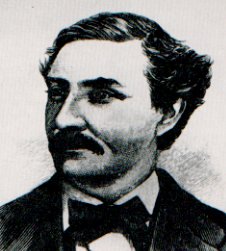 Florida's
backwardness and the need to rebuild the state economy were major
considerations which even the agrarian interests could not overlook. The cotton
kingdom was declining as new cotton fields opened in Texas. The Bourbon Democrats were still
politically conservative, but they weren't ignorant of the realities of Gilded America.
Florida's
backwardness and the need to rebuild the state economy were major
considerations which even the agrarian interests could not overlook. The cotton
kingdom was declining as new cotton fields opened in Texas. The Bourbon Democrats were still
politically conservative, but they weren't ignorant of the realities of Gilded America.
They were
also the major party in Florida
as their Black Codes systematically eliminated most of the African-American
vote, essential to the survival of a statewide Republican Party. Only in Jacksonville and Pensacola
were blacks still in public office by 1880, thanks to Democratic
gerrymandering. The Bourbon plan for a new state constitution in 1885 to oust
the Reconstruction Constitution was the final legal nail on the coffin of
politics.
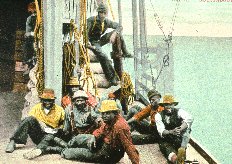 The Civil War had not ended the status of
the agrarian classes. Most rural African-Americans and poor whites found
sharecropping and tenant farming the only routes to survival in much of
Panhandle Florida.
Others choose to vote with their feet by leaving rural Florida. However, until most of the Deep
South, many Floridians headed southward rather than to the North due to the
development of peninsular Florida.
Florida was
the only Southern state in the South who gained black people in the migration
between states.
The Civil War had not ended the status of
the agrarian classes. Most rural African-Americans and poor whites found
sharecropping and tenant farming the only routes to survival in much of
Panhandle Florida.
Others choose to vote with their feet by leaving rural Florida. However, until most of the Deep
South, many Floridians headed southward rather than to the North due to the
development of peninsular Florida.
Florida was
the only Southern state in the South who gained black people in the migration
between states.


FLORIDA ON THE RIM OF THE SOLID SOUTH
Florida politics in the 1870's and 1880's remained
on the rim of the Solid South. sharing many of the serious problems facing the
South after Reconstruction, but other areas of Florida resembled the Western frontier boom,
complete with pioneer farmers, cattlemen, conflicts with the Indians, and
railroad tycoons. Racism was still a factor in Florida,
but did not dominate the dogma of Florida
politics as it did in other Southern areas.
Florida leaders
accepted the notion that Northern moneys were essential to develop South Florida and were reasonably hospitable to the needs
of Northern investors and visitors. The danger of Populist radicalism,
influential in some Southern states by 1885, was treated as another force of
change entering Florida.

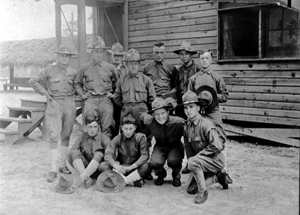
The
Constitution of 1885 and the Black Codes had disfranchised minority opposition.
By participating and regulating the Northern investment into Florida,
most Bourbon Democrats felt a careful alliance with these newcomers would
establish "a new Florida",
a blend of Northern technology and old Southern ways. They thought they would
convinced Northerners of the merits of their goals. In any case, material
progress could bridge a lot of differences.
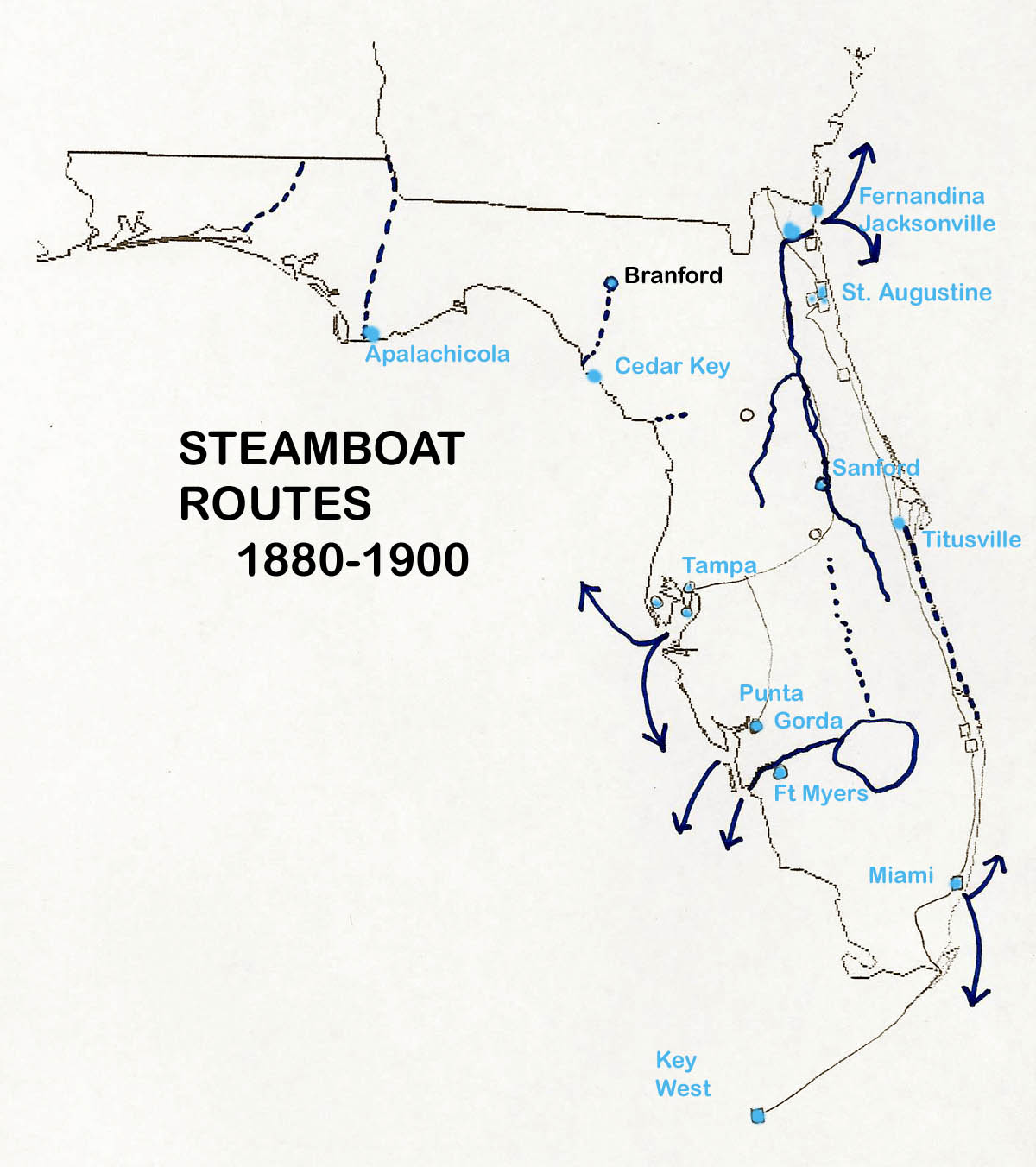
FEARS AND REACTIONS IN GILDED ERA FLORIDA
Rapid changes and a greatly restrictive political system were bound to
create a good many critics. The Constitution of 1885, which would last well
into the twentieth century, may have made Cabinet posts, Supreme Court judges,
and regulators elected officials for the first time, but it was not a document
for reform. The agrarian aristocracy soon allied with the new wealth of
railroad men, lumber men, and citrus growers.
A leading
spokesman for the small farmers against the railroads was Wilkinson Call, a
colorful Populist who got the State of Florida
to establish a Florida
Railroad Commission to stop unfair rate practices. Henry Flagler and Henry
Plant couldn't silence Call.
Less
easily understood by many urban Floridians was the intense development of
Nativism in Florida.
The continued growth of the Klu Klux Klan and other militant groups was due not
just to the demise of black political influence, but due to a fear of the waves
of change entering Florida.
Northerners were changing old institutions.
By the late
1890's this emotional nativism was also directed at the Roman Catholic Church
in Florida.
Under the demagoguery of Tom Watson and the Guardians of Liberty, many rural Floridians believed that
Catholics were loyal only to the Pope. By 1916, anti-Catholic sentiment helped
bolster an obscure Defuniak Springs minister Sydney Catts into the Florida
Governorship. Catts never enacted his most serious attempts to close down
monasteries and nunneries and a counterattack led by Father Michael Curley
changed public opinion in the large cities.
LAST DAYS OF THE STEAMBOATS
While the development of huge railroad lines in the 1890's would
forever end the glamour of riverboat transportation, the Gilded Era was a time
of wonderful steamboat transportation for visitors and Floridians alike. The Yulee rail line from Jacksonville to Cedar Key offered an eighteen
hour excursion where the engineer often stopped the train to check his game
traps along the rail bed.
For thirty
short years, steam boating down the St. Johns River and along the Atlantic Coast became the winter activity for
thousands of Northerners. These Gilded Age travelers started the first regular
tourist industry in Florida
and helped establish dozens of hotels and restaurants that catered to
vacationing tastes.
Steamboats were floating palaces, offering personal service. Fernandina
Beach was the major port for many coastal steamers, although Jacksonville was
the major departure point for the St. Johns River steamboat industry, which in
its peak offered one hundred boats. 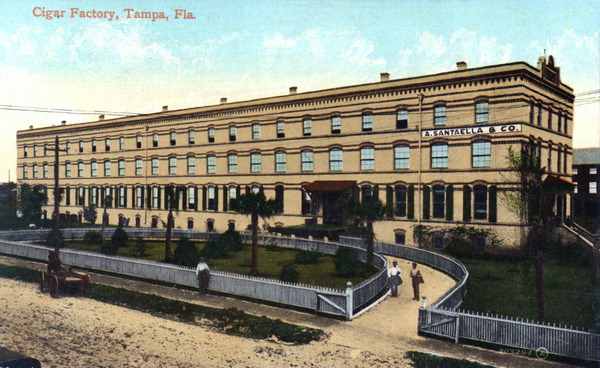 Towns like Palatka shifted from
agriculture to tourism. Everyone seemed to be riding the steamboats. Robert E.
Lee and U. S. Grant took
farewell voyages down the St. Johns River.
Harriet Beecher Stowe waving on the front porch of her winter home in Mandarin
was a popular tourist sight. In 1888 Jacksonville
held the Subtropical Exposition,
Florida's
first World's Fair. President Grover Cleveland attended and then jumped on a
steamboat.
Towns like Palatka shifted from
agriculture to tourism. Everyone seemed to be riding the steamboats. Robert E.
Lee and U. S. Grant took
farewell voyages down the St. Johns River.
Harriet Beecher Stowe waving on the front porch of her winter home in Mandarin
was a popular tourist sight. In 1888 Jacksonville
held the Subtropical Exposition,
Florida's
first World's Fair. President Grover Cleveland attended and then jumped on a
steamboat.
Steamboats
on the Suwannee and Apalachicola were smaller
boats catering more to locals. They lacked the color of St.
Johns vessels like the City of Jacksonville, a $120,000 electric lit
floating palace. Races between rival boats were not just for spectator
entertainment but to convince customers of the merits of the boats. When the
Baya and John Sylvester crashed in a race, the state outlawed the racing
practice.
Steamboats
also took citrus to the North. In 1890, it was discovered that a 12 by 12 by 27
inch crate could safely carry citrus to Northern destinations. Few winter
visitors failed to send shipped fruit back from Florida's
first citrus empire, the St.
Johns Valley.
SPONGING AND WARRIORS OF THE SEA
Rapid railroad and coastal shipping also benefited Florida's long established fishing industry.
South Florida was dominated by Cuban and
Northern fishermen until the profitability of fishing convinced investors to
purchase boats.
The Conchs, the natives of Key West, dominated not just fishing in the Florida
Keys, but also developed a successful sponging operation, using glass bottom
boats and sixty foot spears. This technique could only be utilized in calm
water and along the shallow keys.
In the
1880's Tarpon Springs businessman John
K. Cheyney recruited a New York sponge
merchant named John Cocoris to start a sponge fleet in the bayous and springs
of North Pinellas County.
Cocoris brought in divers from the Aegean
Islands. These Greek
fishermen introduced diving tanks, which revolutionized the Florida sponging industry and delegated the
Conch's to secondary spongers.
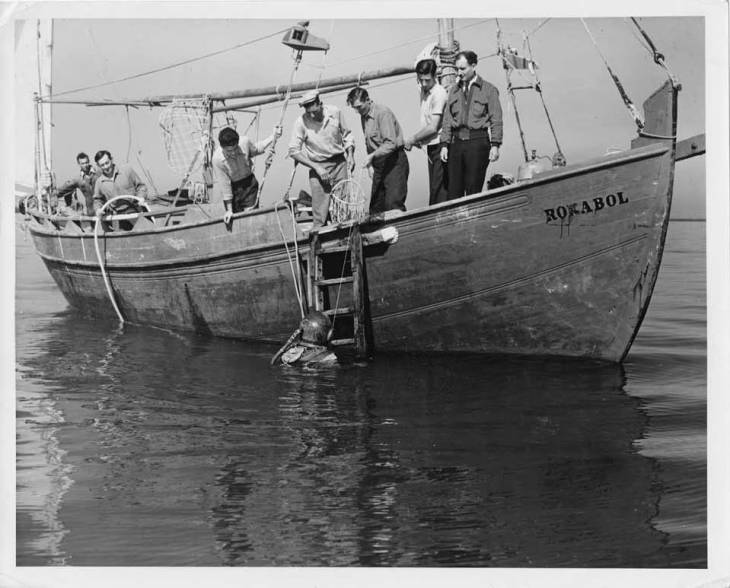

 Soon 200 sponge ships operated out of
Tarpon Springs and a vibrant community of Greek Orthodox settlers was added to
the waves of change in Florida.
Soon 200 sponge ships operated out of
Tarpon Springs and a vibrant community of Greek Orthodox settlers was added to
the waves of change in Florida.
THE CIGAR INDUSTRY OF TAMPA
The Cuban Revolution of 1868 send many Havana
cigar manufacturers to Key West
to avoid the conflict and to develop American markets. Key West proved a costly location since most
advantages was with organized labor.
The
arrival of Henry Plant's railroad to Tampa
Bay would cause a major
change. Key West cigar maker Vicente Martinez
Ybor obtained forty acres of land just northeast of downtown Tampa in 1885. As he imported skilled Cuban
cigar makers, Spanish cigar manufacturers and German box makers flooded into Ybor City,
and later developments in West Tampa, Palmetto
Beach, and Port Tampa.
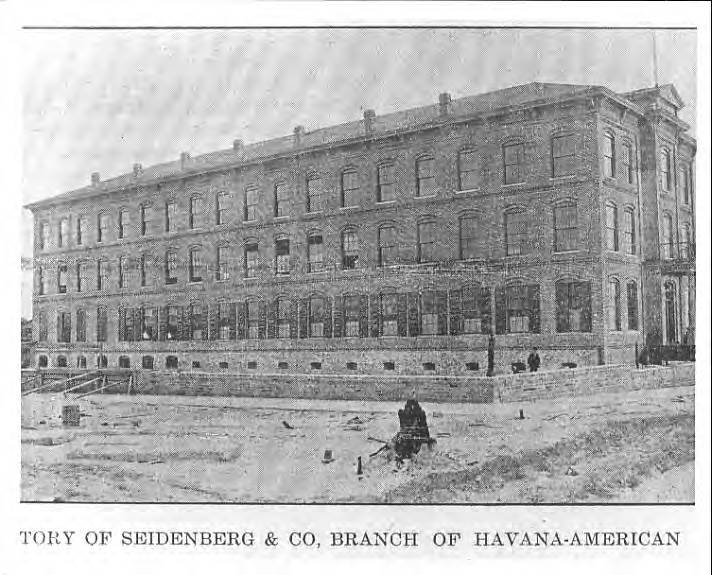
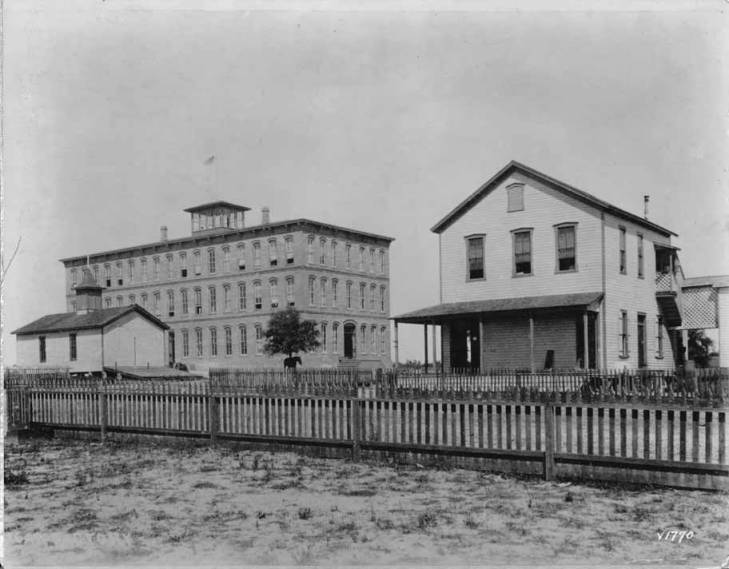 Photographs from Burgert Brothers Photo Collection, Hillsborough-Tampa Public Library Cooperative
Photographs from Burgert Brothers Photo Collection, Hillsborough-Tampa Public Library Cooperative
As Ybor City
boomed, the shocked Tampa
Anglo community decided to incorporate the Latin areas into the city's Third
Ward and assure the control of local politics. Still, Ybor
City changed Tampa into the South's first multiethnic
manufacturing port complete with labor organizations and ethnic clubs.
By 1900 60% of the workers were Cuban (about one-fourth Afro-Cuban), 23% Italian from the Agrigento province of Sicily, and 17% Spanish mainly from Galicia and Asturias. Each ethnic group formed their own clubs and organization. While Spanish and Italian families generally remained in Tampa, the nearness of Havana, just one day by ship, meant many of the single men returned to Cuba.
Most Tampa workers found the Cigar Makers International Union of America (CMIU) too dominated by German cigar making and philosophy, the CMIU continued to try to unite the Tampa cigarmakers with Northern cigarmakers. In bad ecoomic times and times of labor strife, the CMIU recruited Tampans, but the Latin traditions of a rigid status hierarchy of workers of various skills remained strong in Tampa. Tampa's cigarmakers did not fully accept the rules and proceedures from Northern unions. The decline of the local La Resistence union after the 1899 strike helped the CMIU by 1908.
While the fear of immigrants after WWI negatively effected the cigar industry, there were greater economic forces at work to cause the gradual decline of cigarmaking. The rise of cigarettes and cheap mechanized cigar making systems were part of a changing AMerican culture. Second and third generation Latin immigrants in Tampa were going into other occupations or leaving the region alltogether.
THE SPANISH-AMERICAN WAR
Tampa was also the focus of an event that put Florida on the map around the world.
Floridians had been spared the heart-ship of war for forty years, when, almost
overnight, they found a war thrust upon them due to the state's closeness to
Spanish Cuba and the large
Latin population of Tampa.
The desire
of the independence of Cuba
from Spain was not just the
dream of the thousands of Cuban immigrants in New York City
and Florida,
but also of American businessmen who had millions invested in the island.
Floridians not only supported the Cuban revolutionaries, but many Floridians
had participated in gun-running and fund raising for years.
Next to New York City, Tampa's Ybor City
and West Tampa were the centers of Cuban
revolutionary organization. Jose Marti, the George Washington of Cuba, came to Florida many times to
unify the diverse Cuban groups. He was also poisoned by Spanish agents in Ybor City.
When war
finally came, after the mysterious sinking of the battleship Maine,
Tampa was selected as the demarcation port for
the invasion of Cuba and Puerto Rico. Some 23,000 volunteers, an international
press corps, 20,000 observers, and Teddy
Roosevelt and his Rough Riders made Tampa an exciting and confusing global
village.
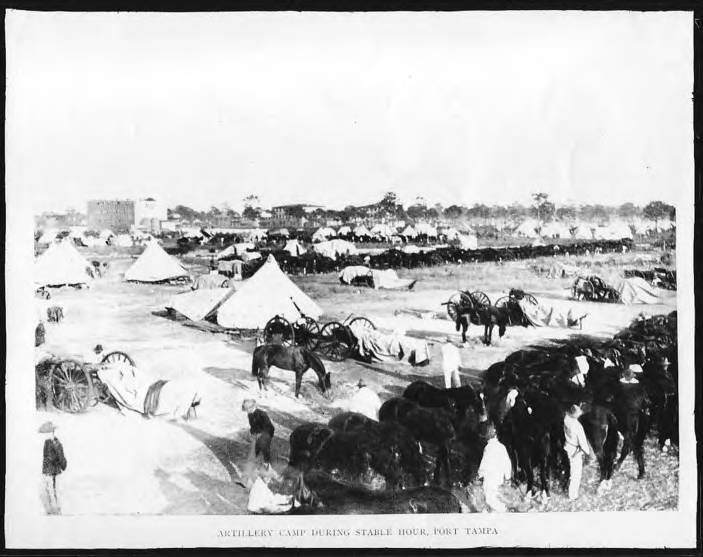
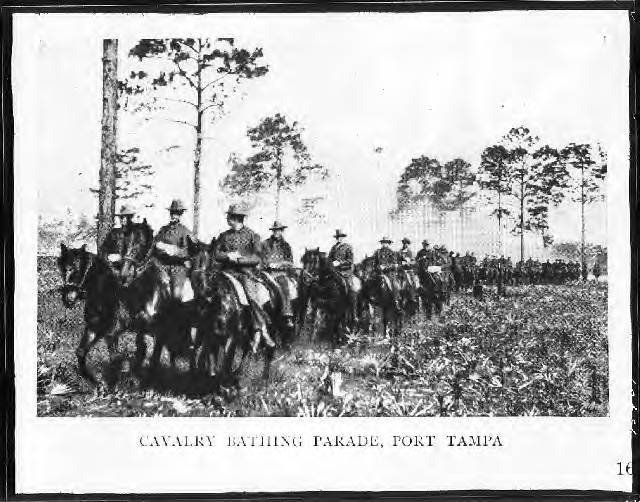 Photographs from Burget Brothers Collection, HCPLC
Photographs from Burget Brothers Collection, HCPLC
The United States
was not prepared for a war. Thousands of freight cars piled up for three
hundred miles. The Tampa Bay Hotel was packed for the first time. There was a
fear of a race riot, for this was the first time Northern, black, and Southern
white units were organized into one military force.
Clara Barton feared Americans would die of yellow fever. Plant's Port Tampa docks could not dock
the 100 ships so horses and supplies couldn't even be loaded into the last
vessels. Fort Desoto,
built at the entrance to Tampa
Bay to stop the Spanish,
was a total waste of construction since it was based on a ship channel map
produced by Colonel Robert E. Lee in the 1850's.
When it
became obvious that all the troops could not fit onto the crude armada, more
soldiers were hurt piling into the ships than landing in Cuba. Finally, General William Shafter agreed to let
the invasion force set sail. The entire world had discovered Tampa.
FLORIDA
IN THE PROGRESSIVE ERA
The Spanish-American War had started a construction boom that would
continue into the 1920's. Many of the soldiers returned to Florida
after seeing how inexpensive land was compared to the Great
Plains and North.
In 1900,
the last state convention of the Democratic Party of Florida
met in Jacksonville.
From then on, Floridians would select their candidates in state primaries.
Rather appropriately, the candidate of the conservative Bourbons D. H. Mayes
lost to reformer William Sherman Jennings.
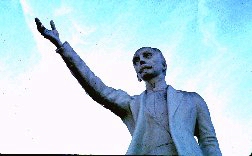 Jennings proposed to expand the role of state
government with programs to help the poor and develop more schools. He even
talked about draining the Everglades for land
reform. Despite these measures, Jennings
was still part of the Bourbon aristocracy that kept minorities and outsiders
under wraps with Jim Crow laws and careful regulations.
Jennings proposed to expand the role of state
government with programs to help the poor and develop more schools. He even
talked about draining the Everglades for land
reform. Despite these measures, Jennings
was still part of the Bourbon aristocracy that kept minorities and outsiders
under wraps with Jim Crow laws and careful regulations.
Jennings' successor Napoleon Bonaparte Broward had
been a gun smuggler in the Spanish-American War and a ruthless opportunists.
Broward was also a firebrand against some of the old power structure and backed
the state's first university system, a railroad regulatory board, and a corrupt
practices law. Progressivism in Florida was tempered by the South's
conservatism and the state's lack of a strong urban, middle class population,
the key to Northern reformers.
Not all
reformers were the progressive kind. Colorful Reverend Sidney Catts mixed Populist
ideas with a strong anti-Catholic and anti-Negro campaign. He drove his Model-T
into Tallahassee
to become Governor despite the opposition of more powerful candidates and most
of the state's newspapers. Catt's plans for change were killed in part by the
outbreak of World War I.
 The Florida
Jim Crow laws were just some of the many reasons why Florida lost talented African-Americans. Asa Philip Randolph of Crescent City
went to New York City and started the Pullman's Union. James Weldon Johnson of Jacksonville was one of
the founders of the NAACP.
The Florida
Jim Crow laws were just some of the many reasons why Florida lost talented African-Americans. Asa Philip Randolph of Crescent City
went to New York City and started the Pullman's Union. James Weldon Johnson of Jacksonville was one of
the founders of the NAACP.
In 1915, the State of Florida
started a state highway program. It became the absolute necessity to the later
development of Florida,
as important as the construction of the railroads in the 1880's. The leaders of
what would become the Florida
Land Boom were already
arriving before World War I.
Carl Fisher was developing the Dixie Highway Association to promote a motor route
from Chiacgo to Miami, a cavalcade first completed in 1915. J. F. Jaudon, another promoter, tried
to convince the state to connect Miami with Tampa. From 1910 to 1920,
promoters and developers were starting a building boom of suburbs in Florida's major cities.
They were meant for Floridians, but attracted a market of Northerners. There
was Telfair Stockton in Jacksonville, Walter
Fuller in St. Petersburg, and Al Swann and
Eugene Holtsinger in Tampa.


 The Civil War had not ended the status of
the agrarian classes. Most rural African-Americans and poor whites found
sharecropping and tenant farming the only routes to survival in much of
Panhandle
The Civil War had not ended the status of
the agrarian classes. Most rural African-Americans and poor whites found
sharecropping and tenant farming the only routes to survival in much of
Panhandle 




 Towns like Palatka shifted from
agriculture to tourism. Everyone seemed to be riding the steamboats. Robert E.
Lee and
Towns like Palatka shifted from
agriculture to tourism. Everyone seemed to be riding the steamboats. Robert E.
Lee and 

![]() Soon 200 sponge ships operated out of
Tarpon Springs and a vibrant community of Greek Orthodox settlers was added to
the waves of change in
Soon 200 sponge ships operated out of
Tarpon Springs and a vibrant community of Greek Orthodox settlers was added to
the waves of change in 




 The
The